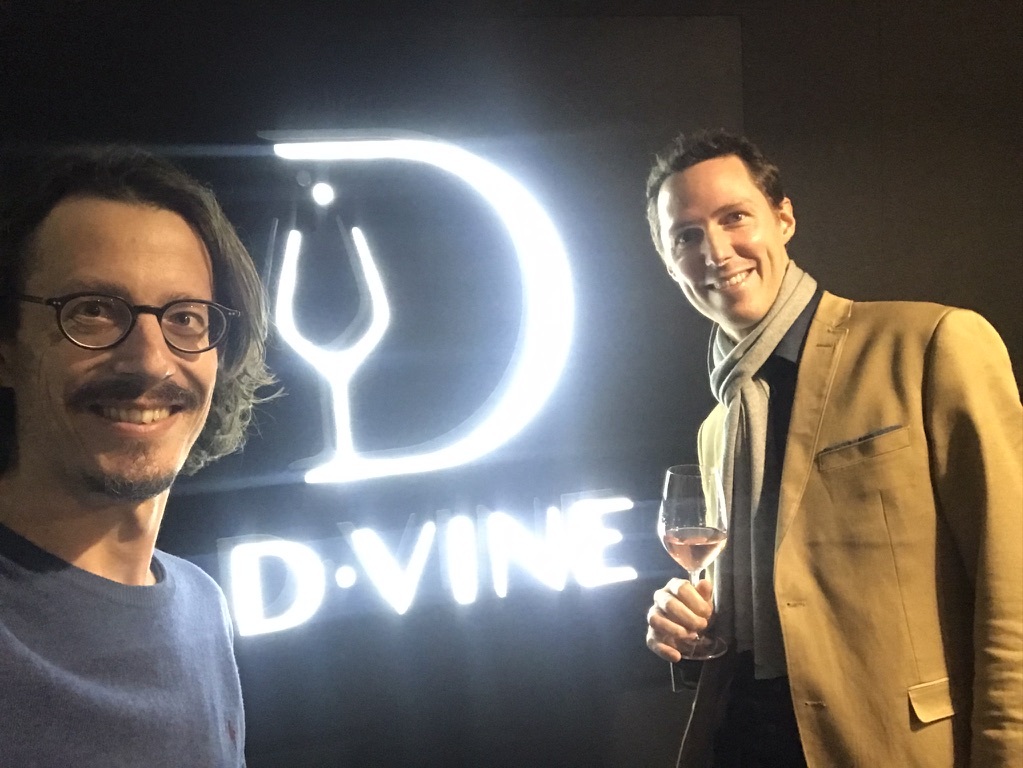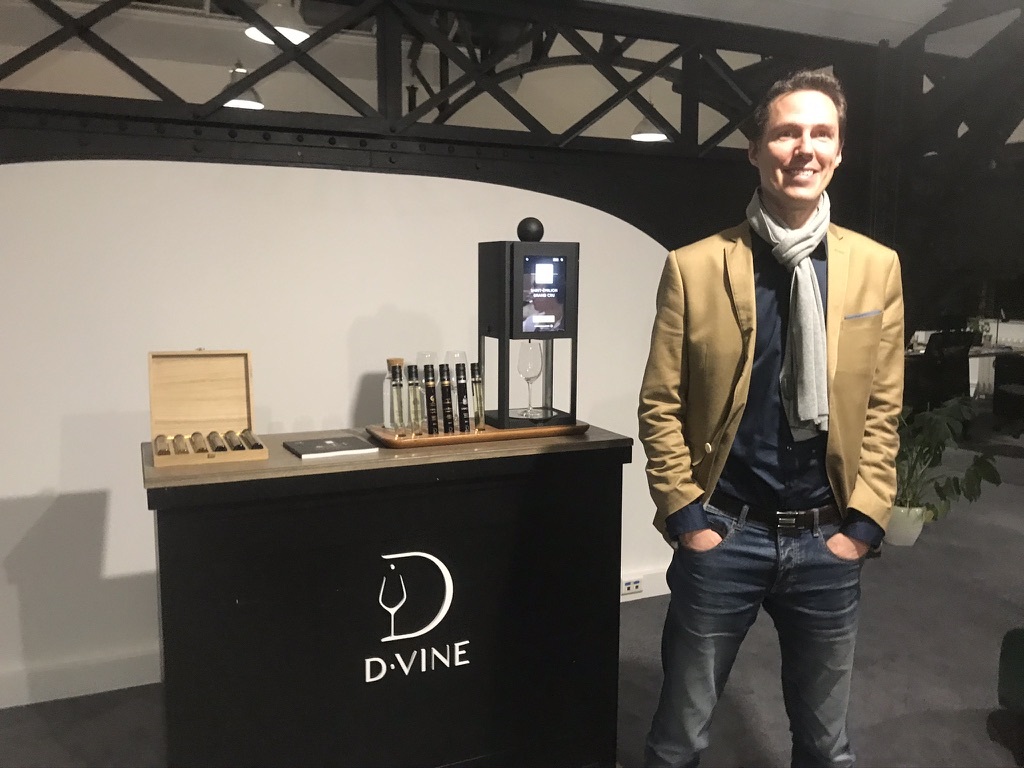Introduction
Nantes, October 28, 2020. Albert, our CEO was to give a conference in Nantes the next day. But that was before. Before Emmanuel Macron announced the second containment. The conference is canceled. Albert is already in Nantes. What can we do? Take the opportunity to share a few drinks and a burger with Thibaut Jarrousse, founder of 10-Vins. Share a few glasses, but also talk about innovation in the Future of Food.
Albert Meige and Thibaut Jarrousse
Launching a breakthrough innovation requires a technological advantage. Launching a breakthrough innovation in a luxury sector, such as wine, also requires successfully positioning oneself in a space structured by established brands concerned about preserving their image. How do you manage a project of industrial innovation in such a world?
Wine tasting is unique in that it is both strongly (50%) influenced by temperature and aeration, and 70% by the glass. This situation leads to a risk of spoiled tasting. Faced with this problem, 10-Vins produces and sells the D-Vine: the first wine-tasting machine by the glass that aerates and warms wine bottles. This project, which originated in 2010, provides valuable insights into the piloting of breakthrough industrial innovation projects in a luxury product context. In this article, we will see why the key to success for these projects lies in business development.
Thibaut Jarrousse
The adventure of 10-Vins
Thibaut Jarrousse trained as an engineer and worked in the Yves Rocher cosmetics group. There, he acquired industrial codes and mastery of operational excellence. Sensitive to the trend from glass to wine and eager to create his own company, he and an associate embarked on the 10-Wine adventure in 2010, leaving his position at Yves Rocher in 2012.
The moment when 10-Vins found its current configuration is around 2017. It is at this time that the company pivoted towards a BtoB sales model, focused on high performance, and eventually optimized in terms of financial and commercial engineering. Financial engineering: the machines have been leased since 2019, which makes it possible to finance the company’s growth with the debt of its customers, for whom the machine is immediately profitable. Commercial engineering: recruitment and structuring of a high-performance sales force, starting in 2017. The sales method is now 38 pages long, and it is a constantly improving process.
At the same time, the launch of the D-Vine Connect, more didactic (2018), as well as continued development to improve the performance (speed) of the machine.
Challenges overcome
It is not useless to come back to the challenges overcome by 10-Wines, especially during the period preceding the pivot towards BtoB. Because in reality, the first years of the project will be experienced as a crossing of the desert. It is during this period that the development of the machine takes place. The company also surrounds itself with a community: this is what will allow it to launch crowdfunding in 2015 under good conditions. The machine will be offered there at a unit price of 250 euros. But, on the side of the prospective industrial partner, the proposed cost price is initially around 6,000 euros. The gap is due to industry best practices in very large-scale production. It is necessary to change paradigm and reason on a smaller scale, which makes it possible to make production costs reasonable and limit losses on sales. The company loses money but puts the machine in the hands of customers. In 2016, the company gains visibility: participation in the CES in Las Vegas and in the Davos Forum, as part of Emmanuel Macron’s delegation.
During the years 2016-2017, the company is facing head-on the question of the branding strategy of prospective industrial partners. The reluctance of potential partners to commit their established brand to a new product invites 10 Wines to adopt a low stance towards them, to prove that the product is good enough for the brand. Moreover, the BtoC business model appears unsuitable. The success of Nespresso, based on the sale of consumables, and has required 20 years of effort, is not transposable to the field of wine tasting.
As we have seen above, the real solution comes from the choice to concentrate the company’s focus on the BtoB segment. The success with companies in the prestige catering sector improves the position of 10-Vins vis-à-vis large groups, establishing a supplier-customer relationship in the partnerships.
Large groups and startups faced with disruptive innovation
The adventure of 10-Vins highlights three major differences between large industrial groups and startups:
- Large groups tend to operate with a fixed scale of operational excellence, where a startup needs to be flexible. We have seen this above in relation to the production of crowdfunded machinery.
- The development of the first version of the D-Vine triggered a lot of enthusiasm (wow effect) among the first users. But it was necessary not to follow the habits acquired in the industry, where the first versions had to be flawless. “I was ashamed of the first machine,” said Thibaut Jarrousse, quoting Reid Hoffman, co-founder of LinkedIn. In reality, the wow effect is enough to get the first return.
- Capturing this initial feedback from users and customers is crucial, as it is what efficiently guides the development of the machine. How do you know what to ignore, and what needs to be improved? Problems identified upstream are not always the ones that catch the attention of customers! Another tricky problem: which customers should be listened to? For 10-Vine, the choice has been made for professionals.
The main advantage of a startup is its ability to go and react faster. The time scale in a large group is not the same, and slowing down to “bet” everything on one big partner is dangerous.
“Our best collaborations with large accounts are commercial, the other subjects (R&D, mutualization …) should, in my opinion, come eventually in a second step, and not the opposite …”. – Thibaut Jarrousse, Founder, 10-Vins
Conclusion
Today, the success of the D-Vine has led the company to hesitate to venture into the takeaway sales niche (which has been very stimulated lately due to the health crisis): should we or should we not risk tarnishing the brand image of the D-Vine used by restaurant owners? But asking this question proves that the company has managed to impose itself and to draw a perspective in the vast space of the future of food.
We have thus seen that breakthrough innovation can work in a luxury field and that a sure way to achieve this is to focus the company’s efforts on a well-defined segment (here BtoB), by giving itself the means to succeed (salesforce, sales financing). By making its commercial weapons, a startup gives traction to its breakthrough innovation and strengthens its position vis-à-vis all its partners.






Bonjour Jacques et Albert,
Bravo pour cet exercice de prospective du futur de l’alimentation.
*+ Le segment retenu des vins et alcools est le premier exportateur des industries agro-alimentaires françaises devant celui des céréales car les vins, alcools et spiritueux y sont répertoriés en IAA aujourd’hui mais pourraient être logés en industrie de la santé si la valeur fiscale enregistrée de l’éthanol de bouche venait à être substituée par des extraits de cannabis psychotropes comme la DHC , candidate possible à l’innovation de rupture suggérée. D’autres modèles de consommation alimentaires à forte rentabilité,incluant ou non les produits de luxe sont ils cependant envisageables ?
Les besoins de consultance stratégique RD de l’industrie alimentaire française ou internationale peuvent-ils aussi être illustrés par celui de la consommation de la viande tel que vous l’illustrez ?
*++ Pour y répondre je vous propose le regard croisé de Fleury Michon un des leaders de la charcuterie industrielle française qui commente par son ancien directeur marketing David Garbousse le dilemme des produits alimentaires ultra transformés dans le film documentaire d’Arte intitulé «la-grande-malbouffe ». Ce film illustre votre propos sur les apports de la transparence et de la prise en compte de la valeur nutritive des produits alimentaires industriels ultratransformés grâce à la production industrielle comparée du cordon bleu de dinde Label Rouge ou de cordon bleu de viandes anonymes ultratransformées et conforme au droit alimentaire communautaire dans un établissement TPE de Licques ( Pas de Calais). Lien source :
https://www.arte.tv/fr/videos/091150-000-A/la-grande-malbouffe/
Je suggère par cet exemple d’inclure des nouvelles disciplines scientifiques à votre grille d’analyse prospective de l’alimentation comme l’ethnologie et l’anthropologie de l’alimentation à adosser à la physiologie médicale de l’alimentation humaine et animale pour systématiser la complexité du sujet d’innovation de rupture alimentaire à résoudre. Les registres des urgences hospitalières renseignent en particulier sur les carences nutritionnelles imposées et parfois mortelles pour les nourrissons que s’imposent des consommateurs de substituts de viande.
Bien à vous,
Michel Serpelloni
Merci Michel je vais regarder cela
Bravo pour cette start up !
Pourquoi ne pas s’allier à un vendeur de matériel pour la vinification tel Pellenc, qui a un rayonnement mondial ?
Contacter Damien DEBUF
Cette innovation pourrait peut-être sa ppliquer à d’autres secteurs de la boission ou bien des liquides (huiles végétales?)
Cdlt
H Mercat